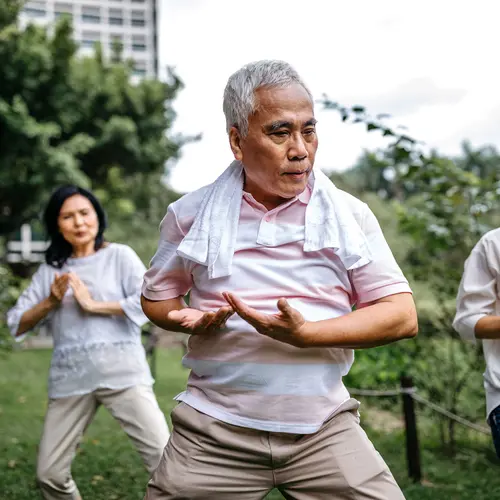Want to feel less stressed? Add touches of the great outdoors -- moving water, plants, and images of nature in artwork -- to your home. Want to feel more energetic? Splash a touch of red around your living room.
Sound flaky? Think again.
The field of health design is attracting increased attention these days, from consumers and healthcare professionals alike, as research mounts that our environment can have a profound effect on our physical, mental, and spiritual health.
"To be truly healthy, we need to feed all areas of our life," says Hope Karan Gerecht, a feng shui practitioner in Stevenson, Md. "The key word is balance," says Gerecht, author of Healing Design: Practical Feng Shui for Healthy and Gracious Living.
Feel Good With Feng Shui
Feng shui, a Chinese system of interior and exterior design that dates back thousands of years, is based on the idea that the items in our homes, and how they're arranged, can affect our life.
According to Gerecht, who has been practicing feng shui since 1988, the three fundamental principles of feng shui are to improve our lives by
- Encouraging the flow of vital energy (chi) in our living environments.
- Eliminating negative energy (sha).
- Creating balance in our homes by including the five aspects of nature --water, wood, fire, earth, and metal.
Gerecht's three general rules of feng shui that support these objectives are to
- Have nothing broken in your home.
- Get rid of clutter.
- Rid yourself of things you do not love
Details, Details
When Gerecht enters a client's home for a consultation, she looks for subtle clues that the environment isn't supporting the people in the home the way it should. A door opposite a window, for example, means that energy is flying out of the room. Gerecht will use plants or hanging leaded crystals to slow down the movement of the chi. If a client is having trouble sleeping, she will look to see where the bed is arranged and what surrounds it. Placing the head of the bed against the wall, for example, and using a solid wooden headboard add a sense of stability and improve sleep, she suggests.
"There is much research now that shows a relationship between our environment and health," says Gerecht, "something feng shui has been saying for centuries." For example, seasonal affective disorder (SAD), Gerecht says, can be traced to a lack of light. One of the principles of feng shui is that all spaces in our home and workplace should be brightly lit (unless you're trying to create a specific mood). "Brightness supports more physical movement, and movement is life-giving," she says.
Certain body postures affect our psyche, Gerecht says. By placing items at higher levels -- hanging plants (especially in bright, shiny pots), mobiles, or crystals, for example -- we are forced to lift our head. "When our attention is lifted, our energy follows," she says.
This isn't hocus-pocus, says Santa Rosa, Calif., architect Carol Venolia, author of Healing Environments: Your Guide to Indoor Well-Being, and co-founder of the National Building Network. Venolia, who first became interested in how buildings affect our health and ecosystems about 30 years ago, "when there really wasn't a lot to learn back then," says that light, color, sound, air quality, even symbolism, all play a role in how we feel.
Hospitable Hospitals
This area of concern is finding its way into our homes and offices, but it's also entering healthcare institutions, says Venolia. "Designers and researchers are increasingly looking at how our surroundings can help us heal and thrive," she says.
In a 1984 issue of Science, Roger S. Ulrich, PhD, of Texas A&M University reported results from a pivotal study on healthcare design. After examining records from a hospital recovery wing, he found that patients whose windows looked onto a green landscape had shorter postoperative stays, took fewer pain medications, and received fewer negative medical evaluations on their charts than patients with similar conditions whose windows looked out onto a brick wall.
More and more healthcare institutions are acknowledging Ulrich's findings and are beginning to incorporate aspects of healing design into their spaces, says Venolia. To promote relaxation, the University of Arizona's Integrative Medicine Clinic
- Uses diffusers to spread the scent of lavender.
- Decorates with a lot of blues and greens.
- Has fresh flowers brought in every day.
CD players in each room mask routine hospital sounds, and the art on the walls is chosen for serenity.
The Planetree Model, says Venolia, is another healthcare design philosophy based on the idea that a nurturing physical environment can promote healing. Hospitals subscribing to the Planetree theory have many elements in common, including
- A homelike, non-institutional atmosphere.
- Artwork.
- Soft lighting.
- Soothing colors.
- Carpets.
You don't have to go to a hospital, though, to take advantage of a healing environment, says Venolia. The first and most powerful thing you can do in creating a healthier home of your own is to be aware, she says. "Tune in to your senses," she says. "Note what's around you and how it affects you. If something is annoying you or making you feel bad -- whether physically or mentally -- that's what you need to fix first."

